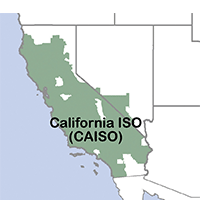In 1996, the Federal Energy Regulatory Commission (FERC) took steps to increase competition in the electricity market and ensure there was no discrimination regarding transmission access. As a result, FERC created seven Regional Transmission Organizations (RTOs) and Independent System Operators (ISOs) to run the high voltage electric transmission grid in North America and Canada.
In California, the flow of electricity is largely managed by CAISO. In this article, we’ll explore the question of “what is CAISO?” and why it’s a key player in the U.S. energy market.
ISO/RTO Documentation Chatbot
Use our AI to search Business Practice Manuals from ISO/RTO markets at no cost.
What does CAISO stand for?
Headquartered in Folsom, California, and incorporated in 1988, CAISO, or the California Independent System Operator, is the only independent grid operator in the western U.S. Understanding the CAISO meaning and what it stands for is important, as the organization plays a crucial role in managing California’s electricity grid.
Pacific Gas and Electric Company (PG&E), San Diego Gas and Electric (SDGE), Southern California Edison (SCE), and more than a dozen municipal and investor-owned utilities participate in CAISO, meaning the organization’s territory covers 80% of California and a small section of Nevada.
CAISO manages nearly 26,000 miles of transmission lines, facilitates over 28,000 daily market transactions, and serves more than 30 million people. It also plays an important role in integrating renewable energy resources into the grid, a hot topic in California thanks to the state’s ambitious sustainability, carbon reduction, and renewable energy production goals.
What does CAISO do?
As noted earlier, CAISO is an independent system operator. In line with its mandate from FERC, CAISO is a nonprofit entity that does not sell electricity to end users, nor does it own generators, power lines, or other equipment. Rather, it’s responsible for the safety, reliability, and security of the bulk power transmission system in its footprint. It does this in three primary ways.
Wholesale electricity market
First, CAISO coordinates the movement of electricity across its service territory with the management of a wholesale electricity market. It offers both a day-ahead and real-time energy market.
As the market coordinator, CAISO is responsible for balancing the needs and equitable access of all market participants, as well as ensuring the reliability of the grid at the lowest cost possible.
Ancillary services market
CAISO also operates an ancillary services market to maintain grid stability and reliability. Its regulation products ensure the grid’s frequency is a relatively constant 60 hertz. It automatically controls regulation resources by sending signals to increase or decrease operating levels based on needs.
CAISO also has spinning and non-spinning reserve products as a part of its ancillary services market. Spinning reserves are standby capacity that is grid-synchronized and can deliver energy within 10 minutes. Non-spinning reserves do not maintain continual synchronization with the grid but can be quickly synchronized and ramped to meet a specified load within 10 minutes.
Learn more in our blog post, “What Are Ancillary Services in Energy?”
Western Energy Imbalance Market
Unlike other ISOs and RTOs such as PJM, CAISO does not operate a capacity market. However, it does facilitate the Western Energy Imbalance Market (WEIM), the only real-time energy-only market in the U.S.
Designed to leverage resource diversity across several Western states, including California, Oregon, Washington, Utah, Idaho, and Wyoming, nearly 25 utilities participate, or are planning to participate, in the WEIM. The WEIM enables energy transfers between balancing areas so members can automatically buy and sell lower-cost electricity near the time it’s consumed.
Optimize your CAISO participation with PCI Energy Solutions
PCI Energy Solutions offers a range of powerful tools for optimizing your participation in the CAISO market and the WEIM, as well as managing the resulting settlements. Contact us to learn more.








